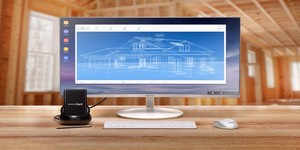Canonical promises Ubuntu Edge-like convergent smartphone
May 5, 2015 | 11:37
Companies: #canonical #ubuntu

Canonical's Mark Shuttleworth has claimed that his vision for a converged smartphone-PC hybrid device is to come to fruition before the year is out, following the failure of the Ubuntu Edge crowd-funding campaign.
Unveiled in July 2013, the Ubuntu Edge promised backers the world: a top-end smartphone using only the best and fastest components, scads of storage and a whopping 4GB of RAM. The latter was a requirement, as the handset - which never progressed beyond a hollow plastic mock-up - was to run the full-fat Ubuntu Linux operating system, which could act as a smartphone while also doubling up as a desktop PC when connected to an external display, keyboard and mouse. The crowd-funding campaign sought a whopping $32 million to fund production of the device, but in August the campaign ended well short of its goal - which may have been Canonical's intention all long, having whipped up a storm of enthusiasm for the Ubuntu Touch platform without having to produce any devices.
Since then, several handsets featuring Ubuntu Touch have hit the market but none have included the high-end specifications of the Edge - nor have they featured the ability to act as a desktop PC and interface with external devices. That is set to change, with Canonical founder Mark Shuttleworth taking time out of a launch keynote to claim that an Edge-like convergent smartphone will launch before the end of the year in partnership with an as-yet unnamed original equipment manufacturer (OEM.)
The device, specifications of which have not been announced, will include the Edge's ability to interface with an external display, keyboard and mouse in order to act as a fully-featured desktop PC. While previous Ubuntu Touch handsets have used the ARM architecture, it is possible this specifically-convergent device could run an Intel Atom processor - giving it improved compatibility with software written for x86-architecture desktop machines, although Shuttleworth has indicated that the focus is to be on 'Convergent Apps' - software which is specifically written for the device and can scale from small to large screens.
A formal launch date has not yet been provided, nor has pricing been mentioned - but at least this time the device shouldn't have to rely on crowd-funding campaigns to get produced.
Unveiled in July 2013, the Ubuntu Edge promised backers the world: a top-end smartphone using only the best and fastest components, scads of storage and a whopping 4GB of RAM. The latter was a requirement, as the handset - which never progressed beyond a hollow plastic mock-up - was to run the full-fat Ubuntu Linux operating system, which could act as a smartphone while also doubling up as a desktop PC when connected to an external display, keyboard and mouse. The crowd-funding campaign sought a whopping $32 million to fund production of the device, but in August the campaign ended well short of its goal - which may have been Canonical's intention all long, having whipped up a storm of enthusiasm for the Ubuntu Touch platform without having to produce any devices.
Since then, several handsets featuring Ubuntu Touch have hit the market but none have included the high-end specifications of the Edge - nor have they featured the ability to act as a desktop PC and interface with external devices. That is set to change, with Canonical founder Mark Shuttleworth taking time out of a launch keynote to claim that an Edge-like convergent smartphone will launch before the end of the year in partnership with an as-yet unnamed original equipment manufacturer (OEM.)
The device, specifications of which have not been announced, will include the Edge's ability to interface with an external display, keyboard and mouse in order to act as a fully-featured desktop PC. While previous Ubuntu Touch handsets have used the ARM architecture, it is possible this specifically-convergent device could run an Intel Atom processor - giving it improved compatibility with software written for x86-architecture desktop machines, although Shuttleworth has indicated that the focus is to be on 'Convergent Apps' - software which is specifically written for the device and can scale from small to large screens.
A formal launch date has not yet been provided, nor has pricing been mentioned - but at least this time the device shouldn't have to rely on crowd-funding campaigns to get produced.

MSI MPG Velox 100R Chassis Review
October 14 2021 | 15:04








Want to comment? Please log in.